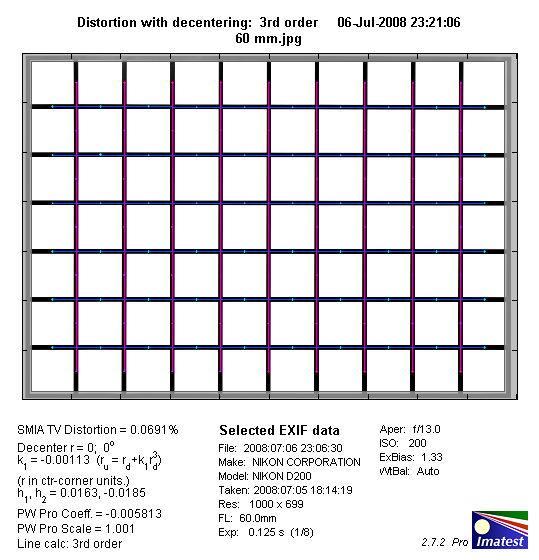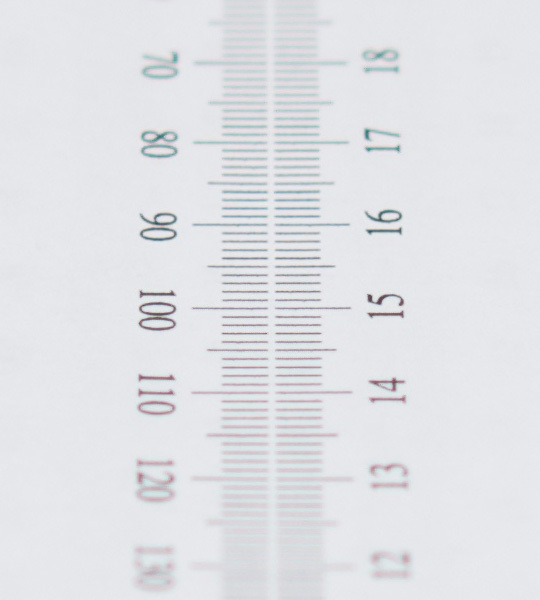|
Micro-Nikkor AF-S 60mm f/2.8 G ED N - Review / Test Report - Analysis |
|
Lens Reviews -
Nikon / Nikkor (APS-C)
|
|
Page 2 of 3

Distortion
As to be expected from a fix focal micro lens, the distortion level is very low at just around 0.07%. Allthough measurable in the lab, this can certainly be regarded as distortion-free under field conditions.

The chart above has a real-world size of about 120x80cm.
Vignetting
As a full frame lens the AF-S 60 enjoys the usual sweet spot advantage on the APS-C test camera. Nonetheless, there's a moderate level of vignetting at f/2.8, which is reduced to a negligible degree by stoping down to f/4 or beyond.

MTF (resolution)
As to be expected from a fix focal micro lens, the resolution figures in the center are excellent wide open already and hardly further improve by stopping down to medium aperture levels. The borders follow just slightly behind with very good figures wide open, scratching excellent levels at medium apertures.
Beyond medium aperture settings
diffraction is the limiting factor so better avoid very small apertures unless there's no alternative. Please note
that this is a physical limitation and not a design issue.
The tested sample was very well centered.
Please note that the MTFs charts below represent the performance near infinity focus. For the time being macro performance tests are not possible.
Please note that the MTF results are not directly comparable across the different systems!
Below is a simplified summary of the formal findings. The chart shows line widths per picture height (LW/PH) which can be taken as a measure for sharpness.
If you want to know more about the MTF50 figures you may check out the corresponding Imatest Explanations
Chromatic Aberrations (CAs)
The predecessor (AF-D 60 Micro Nikkor) surprised with rather high CA values in our review. Despite a major redesign, the sad news is that the AF-S 60 Micro Nikkor isn't any better in this regard. CA peak values of 1.4 px which only drop below the one pixel border beyond f/8 honestly are a little disappointing for a brand new lens. However, CAs can easily be corrected in post processing, so it's not a show stopper, especially if you shoot RAW (or with one of the newer Nikon DSLRs which feature automatic CA removal).

Bokeh
The quality of the bokeh (the out of focus areas) is not only an important property of a macro lens in general. Since the lens behaves like a relatively fast short tele lens on APS-C cameras, smooth bokeh is certainly a welcome feature for this purpose, too.
The AF-S 60 Micro-Nikkor does not disappoint in this regard and is capable to deliver very smooth blur in the out of focus areas. Thanks to 9 rounded aperture blades, background highlights remain their circular shape until stopped down to or beyond f/11. Unfortunately those highlights tend to show a busy, onion-ring like pattern (which is also visible in some of the sample shots on the next page).

Bokeh Fringing / Longitudinal Chromatic Aberrations (LoCA)
LoCAs (non-coinciding focal planes of the various colors) are a common issue with relatively fast glass. As you can
notice below the halos have different colors - magenta (red + blue) in front the focus point
and green beyond. Allthough easily visible in the test shots below, from a global perspective the LoCAs are well controlled for such
a lens. Truly "apochromatic" lenses don't show LoCAs but these lenses are very rare especially
below 100mm.
|
Move the mouse cursor over the f-stop marks below to observe the respective LoCAs
|
| f/2.8 |
f/4 |
f/5.6 |
|

|
|